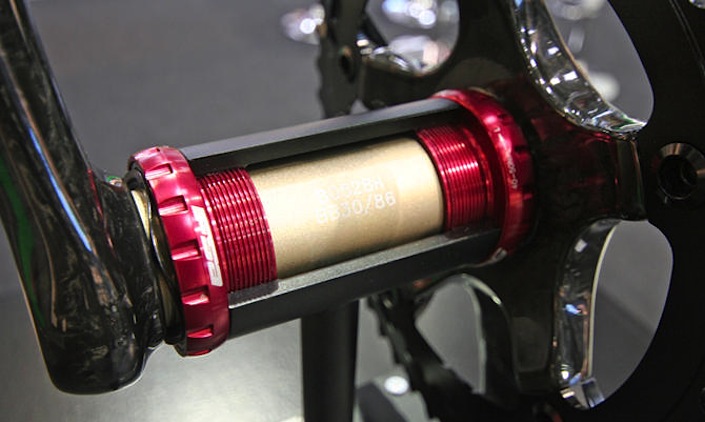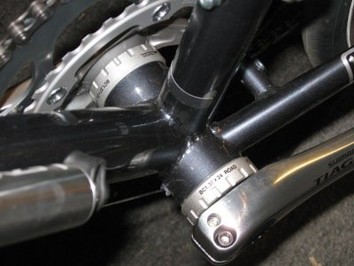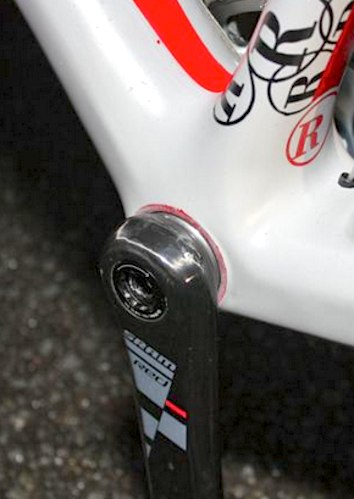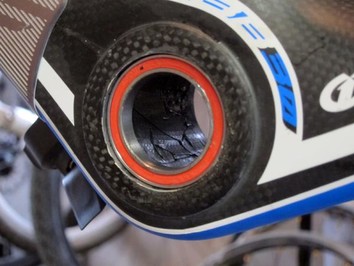
Once upon a time bottom brackets were only moderately confusing...back when there were square tapers and ISIS and the most crucial measurement was the spindle length. Then came the threaded externally mounted bottom brackets which are still common today. And then it got complicated!
What is a Bottom Bracket (BB)? The bottom bracket connects the crankset to the frame and incorporates bearings which allow the cranks to freely spin. It features either a spindle or capacity to incorporate a spindle to which the crank arms, chainrings and pedals are attached. The bearings are either threaded or pressed into the "bottom bracket shell" part of the bicycle frame.
Bottom Bracket Standards
External Threaded

The idea of the modern threaded bottom bracket is to move the bearing cups outside of the frame shell in order to use a much wider 24mm diameter spindle. The most familiar BB of the modern era, Shimano's Hollowtech II, helped this new standard to take off.
The great advantage of these bottom brackets is their ease of service. If there is a creak, unthread it from the shell, clean the threads, grease and thread back on. This can be performed in any typical cyclist's garage, with a couple of common tools, easily and quickly. Also, there is a huge range of cranksets and parts that are compatible with the threaded bottom brackets.
The threaded alloy shells can also be easily 'faced' to ensure perfect alignment during installation. This could be an issue with press fit systems relying on precisely constructed carbon shells.
Although this system was a step up from older traditional bottom brackets, the shell width and spindle diameter are much smaller now compared with more modern designs.
BB90/BB95-PF86/92

These bottom brackets (the BB90/95 from Trek and the PF86/92 used by Giant, Scott and others) use the same bearings and locations as the threaded design. The difference is the bearings are pressed into cups mounted inside the frame. The result is a much larger frame shell but with the capacity to use the same cranksets.
Why? the benefit in creating a wider BB shell is that it allows much larger frame tubes and the ability to space the chainstays further apart. The result is greater frame stiffness and lighter weight.The disadvantages are you need special tools to perform any maintenance and the spindle is still small in comparison with other designs.
Note: BB90 and PF86 are the road bike versions, while BB95 and PF92 are for mountain bikes. The numbers refer to the width of the BB.
BB30

The Cannondale BB30 is probably the most recognised bottom bracket that truly moves on from the standard spindle/bearing sizes of the threaded, BB90 and PF86. On this system the shell width remains the same, but the spindle increases from 24mm to 30mm, and the corresponding shell diameter increases to accommodate the larger bearings.
The benefits? Lighter weight because of the wider diameter spindle, and also discarding the use of two separate bearing cups. By using a narrow BB shell this design also creates more space for heel clearance effectively providing an adjustable "Q Factor".
Press Fit 30 (PF30)
SRAM's PF30 is similar to the Cannondale BB30 system but with a more simplified manufacturing process. The bearings sit in cups which are pressed into the frame, allowing an easing of the tight tolerances required when building the BB30 shell.
This means it is cheaper to build, yet with similar performance. The Press Fit 30 also incorporates extra sealing to keep the bearings protected in harsh conditions.
BBright
This is Cervelo's take on the bottom bracket and unlike all other designs it places the bearings asymmetrically in the frame. The non-driveside bearing has been pushed out 11mm making it similar to a threaded BB, but with the 30mm diameter axle of the PressFit 30.
So far this is only used by Cervelo.
BB386

The newest and biggest of them all is the BB386 EVO as seen on BH bikes. This bottom bracket uses the same shell width as the threaded, BB90 and PF86, but with the 30mm spindle of the BB30 and PF30. As they use the same size and design elements as the other systems, BB386 cranks are cross-compatible with nearly every other design currently available.
It may be the stiffest, but this crankset (like all press fit designs) requires bearing removal tools and a bearing press for assembly/disassembly.
These are just some of the most significant recent designs. There are others, like the eccentric BB's found on some mountain bikes.
Why so many standards?
I don't think looking after the local bike shop was high on the agenda when introducing bottom bracket standard after standard. "Point of difference" is a retail term related directly to marketing. Perhaps I am cynical or just old school, but I do wonder if all these options are looking after the consumer.
Every manufacturer has a take on what makes the stiffest and lightest bottom bracket, unfortunately some of the more recent creations are not friendly to the average cyclist who enjoys maintaining their own bike.
I think the crazy thing is that there is nothing wrong with the threaded bottom bracket. It is cheap to manufacture, provides decent stiffness, is easily maintained and is very robust in the face of high mileage and adverse conditions. It can also be upgraded with the best quality bearings available.
There could be longevity issues with bottom brackets that forgo traditional cups and simply push the bearings directly into the frame. Relying on the sealing of the bearings themselves rings alarm bells.
The other downside is that many of these standards require very precise manufacturing to ensure the BB shell is correctly aligned and faced.
There is a positive side though. Using press-in BB cups or bearings (non-threaded) allows for much wider bottom bracket shells. This allows manufacturers to build frames with more room to attach the chain stays and also to use massive tubing leading down into the bottom bracket area. The result: Increased stiffness and less weight..and it is this combination that drives bike technology and the market.
See your local bike shop for more information, or for a professional opinion on your potential purchase.


